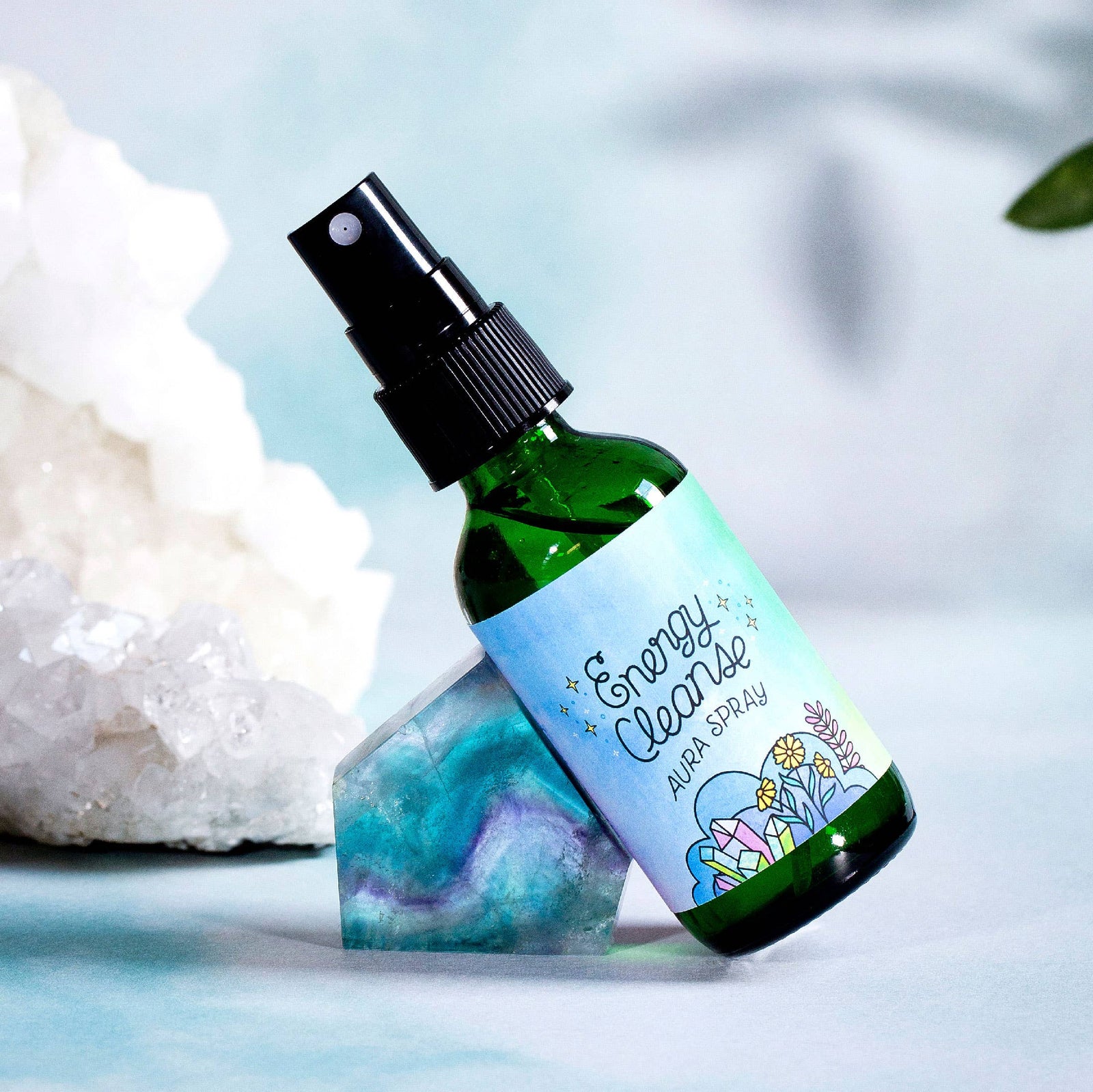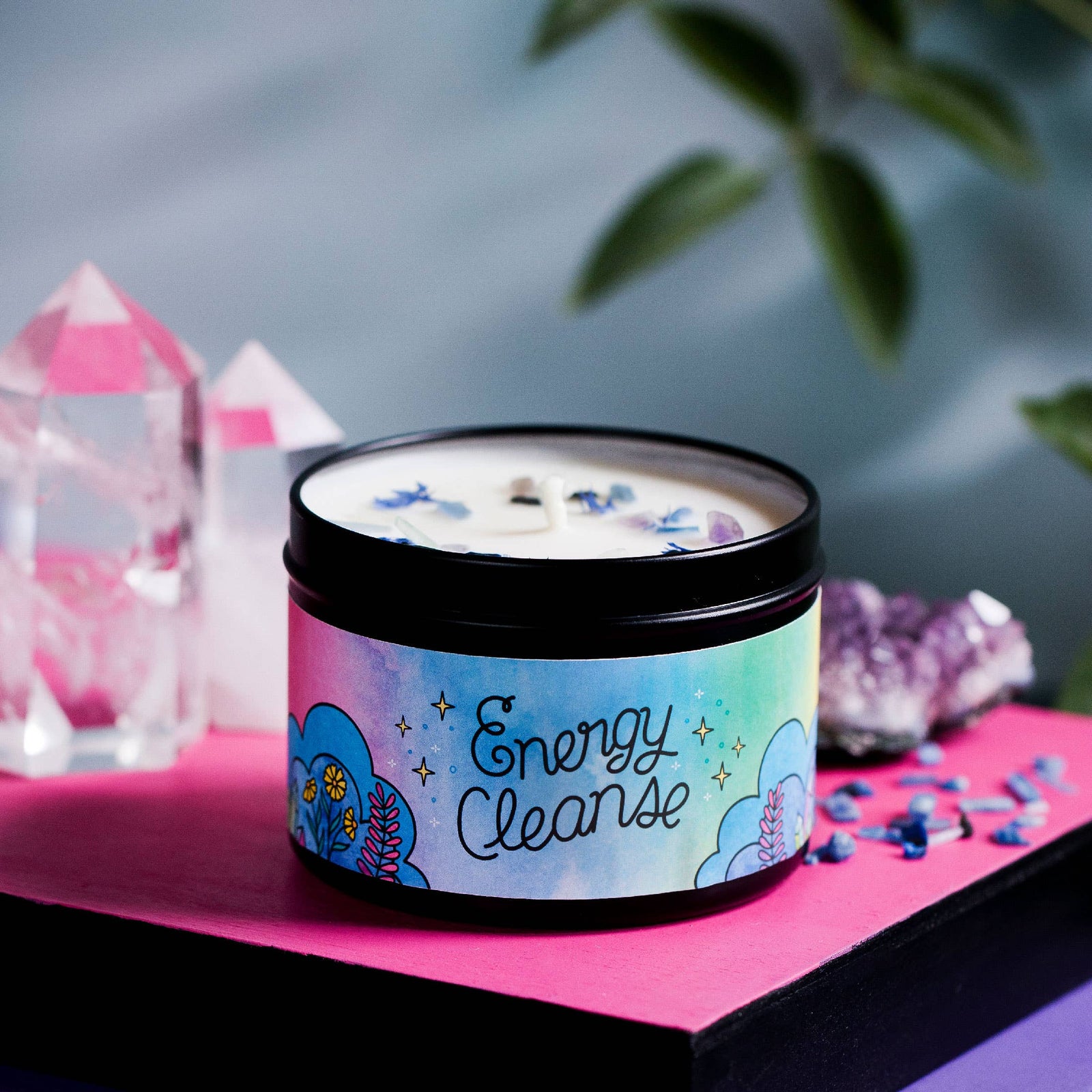Black Tourmaline, as you may guess, is a variety of Tourmaline. This impressive black crystal is colored by high levels of Iron! Giving it a very distinctive opaque appearance, and making it easy to distinguish it from the rest of the Tourmaline family. Black Tourmaline is also called Schorl, and it is actually the most common form of Tourmaline. In my opinion, the fact that Black Tourmaline is the most common is actually a blessing upon humanity; as it boasts such incredible metaphysical properties! Being common allows Black Tourmaline to be readily available for everyone, at a very reasonable price. This fact is especially great for anyone who routinely uses Black Tourmaline in rituals for protection, like your FAQ writer. This magnificent stone can, and perhaps should, be placed anywhere you need protection.
Free US Shipping on orders $99+
Crystal Meanings A-C
Crystal Meanings M-Z
- Malachite
- Morganite
- Moss Agate
- Noreena Jasper
- Ocean Jasper
- Orange Calcite
- Pink Calcite
- Pink Opal
- Pink Scolecite
- Polychrome Jasper
- Prehnite
- Pyrite
- Quartz
- Rainbow Moonstone
- Rainbow Obsidian
- Red Jasper
- Rhodochrosite
- Rhodonite
- Rose Quartz
- Rutile Quartz
- Selenite
- Serpentine
- Shattuckite
- Shungite
- Smoky Quartz
- Sodalite
- Sunstone
- Tigers Eye
- Turquoise
Menu title
This section doesn’t currently include any content. Add content to this section using the sidebar.
Menu title
This section doesn’t currently include any content. Add content to this section using the sidebar.
Menu title
This section doesn’t currently include any content. Add content to this section using the sidebar.
Your headline



Black Tourmaline
Grounding - Protection - Purification
Affirmation
My spirit is grounded deep in the earth. I am calm, centered and peaceful.

Hardness

Chemical Formula
NaFe2+3Al6Si6O18(BO3)3(OH)4
Structure
Hexagonal
Chakras

Root Chakra
Zodiac

Taurus

Gemini

Libra

Capricorn
Energy
The purifying nature of Black Tourmaline acts as a magnet for positivity. Activating the root chakra, Black Tourmaline brings a sense of certainty and assuredness. Bringing your presence into your core leaves your mind to only focus on the now. In such a state, worry, fear, and anxiety cannot remind you of the past or future. Black Tourmaline purifies the mind with this redirection of inner energy. This jet-black stone also fosters stability, both emotionally and physically. It is a great guide in times of transition or uncertainty pertaining to health or relationships.
Placement
Black Tourmaline is a wonderful traveling companion! Due to its powerful dispelling abilities, external negative energies disperse around this stone. If you plan to travel to crowded cities, unsafe areas for work, or venture alone you can keep Black Tourmaline in your pocket or wear it as a bracelet pendant so that its energy is close to your core. Its healing properties will keep you present and aware of your surroundings without causing unnecessary alarm. You will feel a sense of control by focusing on your actions rather than your fearful thoughts.
Ritual
Not only is Black Tourmaline a purification stone, it is also a protector. It’s vibration dispels the negative energies that permeate our home. Especially in modern day, electronic devices radiate waves of EMF. These radiation waves interfere with our connection to the soul and produce distracting, unaligned thinking patterns. To use Black Tourmaline, set it near any devices such as TVs, phones, and computers. Even setting a stone in the kitchen near your microwave can aid in its disturbance to your home. Reinforce Black Tourmaline’s protection power by setting it out under a full moon for a night. The cosmic energy will wash the negative EMF absorbed into the stone. (Make sure to leave near a window or covered outside so Black Tourmaline doesn’t get wet!)
History
The allure of Black Tourmaline and its fellow tourmalines began in Europe around the 17th century. European voyagers from the Dutch East India Company discovered tourmaline on Sri Lanka and found their unworldly beauty as a means of protection. Dutch peoples used Black Tourmaline to clear out ash from pipes in their homes by heating up one end of the stone. Not far off from where we are now, using it to clear radiation waves!
FAQ
-
-
Let’s begin with an introduction to the Tourmaline family! Tourmaline may come in any color, and though Black Tourmaline is always opaque, almost every other form of Tourmaline has the ability to be translucent. These translucent forms of Tourmaline are often rare and more desirable for faceting into gemstones and setting into fine jewelry, due to their color and gemminess. Though the less desirable qualities of these Tourmalines may still be opaque, let's imagine the textbook versions of these crystals, to get a good idea of why they’re so sought after!
In order of the rainbow:
Red Tourmaline or vibrantly Pink Tourmaline is considered particularly desirable and goes by the name of Rubellite Tourmaline.
Orange, Yellow, and Brown Tourmaline go by the name of Dravite which is most frequently colored by impurities of sodium magnesium.
Green Tourmaline can either be Elbaite Tourmaline or in rare circumstances the more intensely green Verdelite.
Blue Tourmaline most often goes by the name Indicolite, which is frequently teal or green leaning in color but certainly has a tint of blue to it. If you see a vibrantly Blue Tourmaline which almost appears neon in color, it is most certainly a copper bearing Paraiba Tourmaline which is considered to be particularly rare!
Finally for Purple Tourmaline, the rarely spoken Siberite is an incredibly vibrant purple variety of Tourmaline hailing from Russia which is a Tourmaline collectors dream.
In addition to these incredibly enticing monochromatic options, Tourmaline has the enchanting ability to be multicolor, and potentially dichromatic. There is a great distinction between these two potential attributes:
For those of you who have just heard of dichromatism for the first time, it is the ability of a mineral to change between two colors. This change is best visible while the crystal is backlit by polarized light, and rotated 90 degrees. The most typical color change for Tourmaline is to shift between a darker color, and a more saturated color, however some may even shift from magenta to slightly violet or perhaps green to teal!
On the other hand a multicolor Tourmaline is one which has two or more easily visible colors to it. The best example of this is the Watermelon Tourmaline, which is green and pink (sometimes also including white). Watermelon Tourmaline may appear as either a long grassy green crystal, crowned with a gemmy pink tip, or more rarely as slices! If you’ve not yet seen a Tourmaline slice, unlike how a pizza is sliced along the vertical, imagine a horizontal slice along a long Tourmaline crystal. This slice exposes an internal pink phantom, typically a smaller section of white phantoming, and then a green outer crust of Tourmaline which looks just like a watermelon!
Tourmaline doesn’t necessarily stop at just 3 colors in one crystal. A single Tourmaline may possess a whole gradient of color, and these rainbow crystals are often featured in high class collections or museum exhibits! If I’ve yet to turn you into a Tourmaline fan, feel free to google these top class specimens in order to fall in love with them as well.
-
From a metaphysical standpoint, Black Tourmaline is a powerhouse of protection! It banishes negativity and instead inspires positive energy to flow. This energy will flow through not only its wielder but also the space surrounding the crystal itself. On the other hand, Clear Quartz is a master healer. It wields not only the ability to be programmed to any intention or desire, but it also can amplify any other crystal. Naturally, these two crystals combine flawlessly both in their physical form and metaphysical properties. The surrounding Clear Quartz flawlessly amplifies the properties of its internal Black Tourmaline. Giving it an even more potent aura of protection, grounding, and energy filtering.
Clear Quartz plays well with all of its crystal siblings, from an energetic standpoint. Black Tourmaline, a distant cousin, is certainly no exception.
-
Black Tourmaline is typically very cost effective, raw or polished: you’re always getting a bang for your buck with this ol reliable crystal! To the same effect, Clear Quartz is also an incredibly common, inexpensive crystal which all of us have the ability to add to our collection with relative ease. However, when Tourmaline grows inside of Quartz, that may add to its rarity depending on a few factors.
For the sake of time, and those of you who would like a quick answer: Yes! Black Tourmaline in Quartz should almost always be a bit higher in price than both Black Tourmaline and Clear Quartz.
For those of you who would appreciate a deeper understanding into this topic:
The first factor of desirability would be the color of the Tourmaline, inside your Tourmalted Quartz specimen. Many colorful varieties of Tourmaline may be found inside or near Clear Quartz, and being a more rare color like pink or green would certainly raise the price of your desired piece. Black Tourmaline in Quartz will generally be less expensive than any colorful Tourmaline in Quartz.
Our next deciding factor for the price of your Black Tourmaline in Quartz would be the clarity of the Quartz itself. The more transparent the Quartz, the more valuable it is considered to be. This rule goes doubly for included Quartz. The reasoning here is quite simple, we all want to see the inclusion as clearly as possible! If you have a more white and milky Quartz it will block the visibility of the Black Tourmaline inside. This would certainly lower (if only slightly) its typical pricing. You’ll most likely find these lower quality white and black Tourmalated Quartz crystals transformed into smaller pieces like beads or pocket stones. With these small pieces being more common, you can enjoy the amplifying energy of Quartz around the protective energy of Black Tourmaline at a decent price.
For the finest quality of Black Tourmalated Quartz, imagine if you will a perfectly clear Quartz crystal, with a myriad of intricate Black Tourmaline streaking through its internal structure, almost as though a lustrous black spiderweb has been forever encapsulated inside! These crystals, if they are large and whole, will often become museum pieces. However if the Quartz crystal is broken or in a massive growth pattern, that is when carvers will take the stage and create beautiful works of art. From freeforms to spheres to skulls and more… These pieces will be for us, the humble crystal collectors, to truly enjoy!
-
This is an often heard debate between not only customers of Rocks with Sass, but most assuredly crystal lovers worldwide: raw or polished?
Though it is true that this discussion could be had over any number of crystals and all of these following facts would hold true: Black Tourmaline is a staple stone which is as good as any other for this topic of discussion.
Let’s first consider the innate metaphysical properties of Black Tourmaline. Black Tourmaline is a crystal well known for protection. It possesses the distinct ability to purify negative energy into positive energy, making it a quintessential protection crystal. Perfect for beginners and aficionados alike: Black Tourmaline also has the natural energy of grounding. Thus allowing us to activate our Root Chakra. With all of this in mind, we now have a good understanding of the energy of any Black Tourmaline crystal, either polished or raw.
We’ll start, as all crystals do, with the raw form. If you’re brand new to crystal healing, the concept of a raw crystal is fairly easy to grasp. It is an unpolished crystal. In the realm of Black Tourmaline, this can mean one of two things: A cluster of Black Tourmaline, typically growing off of feldspar, or a chunk of Black Tourmaline which still holds its natural crystal formation.
It’s particularly simple to differentiate between raw and polished Black Tourmaline, due to its distinctive growth pattern. If you are often averse to raw crystals, Black Tourmaline may be for you due to its potentially lustrous and silky raw form. When Black Tourmaline is highly lustrous, its rich black surface bounces light allowing you to see its intense form more easily. Tourmaline crystals, of any color, grow in a fantastical formation. A trigonal crystal structure causes Tourmaline to grow in a triangle shape. This can be very distinctive, especially in the case of textbook Tourmaline specimens. This unique growth structure also gives it gorgeous vertical striations along its side surfaces. If a Tourmaline crystal is undamaged it may either have a flat tip, or a whimsical geometric patterning that comes to a sloped termination. If you have a single Black Tourmaline crystal with a termination, it is considered a natural point! When growing in a cluster formation, several Black Tourmaline crystals will grow together, often terminating in many directions along the surface of a base mineral. If you have a chunk of Black Tourmaline, without any termination, this crystal would be considered a true ‘raw’ or ‘rough’ piece of Tourmaline.
These terms don't necessarily indicate that the raw material was untouched by human manipulation. Crystals are often broken into smaller pieces, heated, or irradiated. Almost always, crystals are washed with a bit of some kind of industrial soap to separate it from any dirt or matrix barely clinging to a crystal. Each of these processes exist simply to ensure your crystal looks as best it can, squeaky clean and picture perfect.
Here are a few examples of how raw forms of Black Tourmaline may be best utilized:
Black Tourmaline Point: Pointing the energy of protection in a certain direction. For purifying energy; have the unterminated end of the Black Tourmaline facing whatever you would like to purify, and allow the Black Tourmaline to filter that energy out of the object. This will also positively affect space or items on the terminated end of the Black Tourmaline.
Black Tourmaline Raw: These crystals of Black Tourmaline are often fairly inexpensive, often costing even less than their pocket stone counterparts of similar size. They are perfect for placing in the four corners of a room, where they will not be jostled or touched. This kind of Black Tourmalines may also have some pieces crumble off, or come in a bag of small dust. Burying these examples of raw Black Tourmaline in front of your doorstep is an inexpensive option for that time-honored tradition!
Black Tourmaline Cluster: Not the best for carrying around due to the potential that it may eventually break. However, it’s a lovely piece to include amongst your sacred crystal space. It’s an even better crystal to have in your workspace, which may be plagued with negativity.
For the polished variety, there is no end to the possibilities. Both Black Tourmaline and Black Tourmalated Quartz have the ability to be carved into all of the classic shapes we know and love. For the sake of simplicity, we will talk about 3 Black Tourmaline shapes. For those who are typically opposed to polished crystals: Black Tourmaline, when polished, typically has a slight texture to it from its natural striations. So these polished crystals almost always have a lot of personality to them, along with a rich black color and potentially some white feldspar inclusions or brown iron stripes as well.
Tumbled Black Tourmaline Pocket Stone: These are perfect to throw in your purse, under your pillow, or carry around with other polished crystals! The best part of a polished pocket stone is that there are little to no jagged edges. You can safely place this crystal anywhere which you may be scared of scratching anything.
Black Tourmaline Palm Stone: If you’re looking for a grounding crystal with a little more weight to it, a Black Tourmaline Palm Stone would be one of the best options for you! Fitting perfectly to your hand is an added bonus. Like a pocket stone these are simple to carry in a pocket or purse for whenever you feel the need for a little extra protection.
Black Tourmaline Sphere: An excellent dual use crystal, both to hold and to place in a space which should be under the protection of Black Tourmaline’s energy. A sphere evenly distributes energy in all directions, and a Black Tourmaline Sphere is a powerful special energy purifier. Spheres can also be incredible meditation companions, especially for those drawn to fidget while meditating!
For more specific information on shapes, take a look at our blog: Different Crystal Shapes: Their Energy, Meaning, and Uses for Everyday, to see which shape will help you best express the energies of Black Tourmaline into your space!
-
There are many excellent crystals for protection, and there are many different kinds of protection which you may need in your life. It can be important to diversify your collection of crystals for protection for that very reason, to cover all your bases! However, in most respects Black Tourmaline acts as a blanket protection crystal; covering all aspects of protection you may need. It’s an excellent physical and emotional protector, due to it being a transmogrifier of negative energy into positive energy. If you’re feeling clouded by negative energy you can lean on Black Tourmaline to transform not only the energy, but also your perspective on the situation at hand!
If you are searching for protection in your home, a time honored tradition is to place a piece of Black Tourmaline in four corners of each room which needs to be purified. To keep negative energy out of your home altogether, bury Black Tourmaline right outside of your doorstep. Offering Black Tourmaline to household plants or outdoor gardens can also be beneficial, brightening spaces and allowing the positive energy to flow through the plants and into the oxygen it offers you as well.
If you are suffering from too much internal negativity, Black Tourmaline and Rose Quartz will be a perfect pairing for you. Wear a set of bracelets on your left wrist so you attract loving positive energy in, while negating the effects of outside negative energy! When you’re feeling a bit out of sorts, expecting you may be outputting negativity throughout the day, wear this pairing on your right wrist to soften your potentially negative effects on others.
-
You should put Black Tourmaline in your home wherever you feel you need to decrease the negative energy. If you don’t feel confident in your intuition on where to place this powerful protection crystal, try these classic placements! 1. In the sacred spaces of your home, black one piece of raw Black Tourmaline in each of the 4 corners of the room. This may be the room where you practice daily rituals like pulling an oracle card, where you keep your beloved crystal collection, or even your bedroom where you commit the sacred act of rest! 2.Bury Black Tourmaline in front of your doorstep, or sprinkle chips/dust under your doormat if you live somewhere you cannot bury anything! This is said to prevent negative energy from entering your home in the first place, so you may notice a quick turnaround of nosey neighbors or unwanted visitors.
-
Black crystals may be some of the hardest to differentiate between, due to the fact that their most ideal forms are typically pure black. The first step to crystal identification is often color, different hues may be distinct to a particular stone. However with black crystals, there is not too much difference in the undertones of the color. There are a good amount of other ways to tell the difference between black crystals, otherwise it would be impossible for anyone to tell their black pocket stone assortment apart!
Let’s start with the basics: when you hold your black crystal, does it feel abnormally light? Most crystals have a similar heft to them, so if your black crystal feels light as a feather you have 2 excellent options. Either Jet or Shungite. Jet is a form of coal, incredibly light, and if it is particularly well polished it may have a bit of a metallic sheen to it as well. Shungite is also a unique form of carbon, and it is slightly more dense than Jet. These two black crystals will prove difficult for beginners to differentiate between, especially when polished. If you feel like doing a scratch test on your crystals, that may be the best way to tell the difference, with Jet at a 2.5-4 on the Mohs hardness scale, and Shungite at a 3.5-4.
Getting into the big 3 black crystals, which really messed with my head as a crystal identification newbie: Black Tourmaline, Black Obsidian, and Black Onyx. Three powerhouse titles, and each is a must have in every crystal collection! Let’s get into the nitty gritty of how to tell the difference between these black beauties. Black Tourmaline may come to be the most simple out of these 3, with its unique texture it is very difficult to get a completely glossy polish on any Black Tourmaline! Particularly smaller crystals like pocket stones, Black Tourmaline has a distinctive feel to it. With a hardness of 6-6.5, if you feel the need to clarify with a scratch test, Black Tourmaline will be harder than Black Obsidian and softer than Black Onyx.
Black Onyx may seem to be one of the more difficult, as it can get to a wonderfully glassy polish in just the same way Black Obsidian can. However, most Black Onyx has some slight banding and striation to it. Lines of brown and white are likely to appear along its otherwise perfectly black surface. This will be a sure fire sign of Black Onyx. Otherwise with it boasting the Chalcedony family’s decent hardness of 6.5-7, a scratch test will easily put any issues of it being Black Obsidian to rest.
Black Obsidian is a beautifully rich black volcanic glass! These incredibly glossy crystals can be tricky, with a conchoidal fracture just the same as Quartz, figuring it out may take a few additional steps. Often appearing opaque, backlighting your unidentified black stone may immediately show you its Black Obsidian. If your black crystal has translucence along its edges, typically tinted in a warm tone like gold or orange, you have a Black Obsidian crystal most certainly! If this yields no result, and you’re still convinced you have a piece of Black Obsidian, try a scratch test to find if your crystal has a Mohs hardness of 5-5.5!
-
I would venture to say there’s no wrong place to put Black Tourmaline for your daily use, but I know there are those who would take that a bit too far! My personal favorite places to use this incredible stone on a daily basis include: 1. my car, to help negate those crazy Ohio drivers of which I am one. Especially hanging a crystal of Black Tourmaline from your car mirror will help the Black Tourmaline’s essence cascade through your car like a waterfall of positive energy! 2. My purse, as a bit of additional protection against the fabled purse nabbers I see so many of in movies 3. The fun, small pockets of odd clothing items which would otherwise go unused. Such as boot pockets, the third tiny pockets on cargo pants, small pockets that may also be intended for change on some keychains! Just as an extra dash of magic in the mundane.
-
For the aspect of wearing this incredible crystal, there is no way to go wrong! It is lightfast, unlikely to break due to its decent hardness, and non-water soluble. Any form of Black Tourmaline jewelry would be an excellent talisman of protection. In order to increase the potency of your Black Tourmaline rings and bracelets, try interchanging which hand you wear them on. The left arm is how you draw in energy, so in order to negate outside negativity wear your Black Tourmaline pieces on your left arm. Your right arm is how you introduce your energy to the world so in order to negate the effects of internal negativity, wear your pieces on the left! To boost the energy of your necklaces or earrings as well, try to program with them with your preferred intention. Amplify the grounding, protective, or positive energies of your pieces through writing out your intentions, or simply meditating with these pieces in your right hand while concentrating on your intention!







